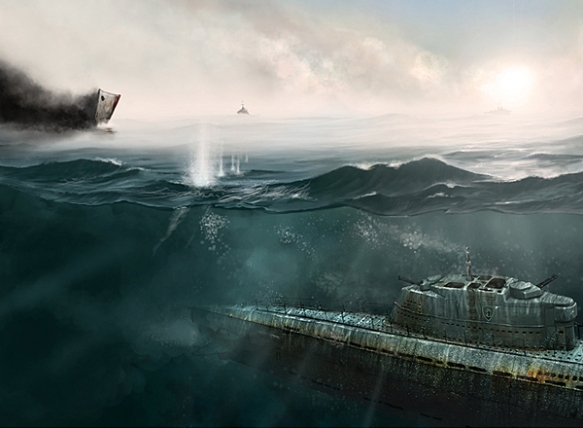
Thus the Germans produced three revolutions in submarine performance virtually simultaneously: the snorkel, the 15-17-knot ‘electric’ submarine (Types XXI and XXIII), and the 25-knot Walter boat. In 1948 the US evaluation was that World War II ASW developments had essentially solved the non-snorkel submarine problem; for example, the ‘fleet type’ could expect to exchange 2 boats for every merchant ship sunk. Even a snorkel submarine with limited underwater speed and endurance would be almost completely ineffective; it was estimated that the Type VIIC (snorkel) would exchange 1 submarine for every 6 merchant ships sunk.
Existing escorts would find attacks on a 17knot submarine relatively difficult. For example, Odax, the first US ‘Guppy’ (effectively a Type XXI equivalent) was able to outrun a destroyer escort in any substantial sea by heading into it. The fast submarine could cover the range of wartime sonars so quickly that it could escape detection by speed alone. This tactic was defeated only with the advent of reliable long-range sonars such as the US SQS-4 and its successors; as late as 1973 the Soviets, who generally lag behind in sonar design, were credited with reliance on speed, rather than on deep diving and silence, for evasion.
A 25-knot submarine like Type XXVI would be able to counter-attack; it could expect to outrun attackers in the North Atlantic. Even so, it would be limited by the need to refuel: the submarine could not, in effect, recharge underwater power plant by creating new peroxide while snorkelling. On the horizon was the nuclear submarine able to sustain 25 knots for 60 days rather than 10 hours. It would be able to attack a convoy with very long-range torpedoes, never coming within sonar range.
The British view at this time (about 1948) was that the greatest advance was in intermediate speeds and in underwater endurance at low speed. Increased torpedo performance was equally important, because it permitted a fast submarine to attack from beyond sonar range. Range was tripled, and speed increased, with lethality maintained by the use of homing and pattern-running torpedoes. The new torpedoes could he adjusted to take any target angle. The Allied navies already had periscope ranging radars to achieve better torpedo fire control. In effect, there were no longer submerged limiting lines of attack for target speed below about 25 knots. They had been replaced by limiting areas of approach.
The Royal Navy discounted the 15-knot underwater speed as an improvement in survivability; wartime experience showed that the best hope for a detected submarine was counter-attack, possibly with homing torpedoes. Shortly after the war it expected the next step to be the underwater wolfpack, coordinated by underwater telephone. The fear of detection was considered over-rated; only one wartime case had been found of a submarine being heard, and in that case it was transmitting directly at an escort, at short range and at full power.
During 1944 and 1945 the extent of the revolution became apparent to the VS and Royal Navies. They had to react on two levels; submarine development proper, ie the exploitation of the new technology, and new countermeasures, which latter required a wholly new concept of ASW.
At the simplest level, the snorkel (snort in British parlance) could be fitted to many submarines. With the ‘A’ class under construction late in 1944, a snort was hurriedly designed. Tested in HMS Truant the following year, it was placed III production for the entire ‘A’ class and for most other British submarines. Actual installation was slowed by the end of the war, but the programme showed what could be done rapidly. Meanwhile, a design was prepared for an improved ‘A’ class submarine. It began with relatively minor change (including snort), but by July 1945 Flag Officer (Submarines), Rear Admiral George Creasy, wanted a wholly new design comparable to Type XXI, with large battery capacity, a snort, and much streamlining; there would be no deck gun. There was some hope that the conventional powerplant would ultimately be replaced by a Walter turbine, but, within a few months this design, too, had been rejected in favour of a purely experimental Walter boat, which became HMS Explorer. Ironically, the first British submarines actually completed after the war were closer in concept to the original 1945 design: the Porpoise class.